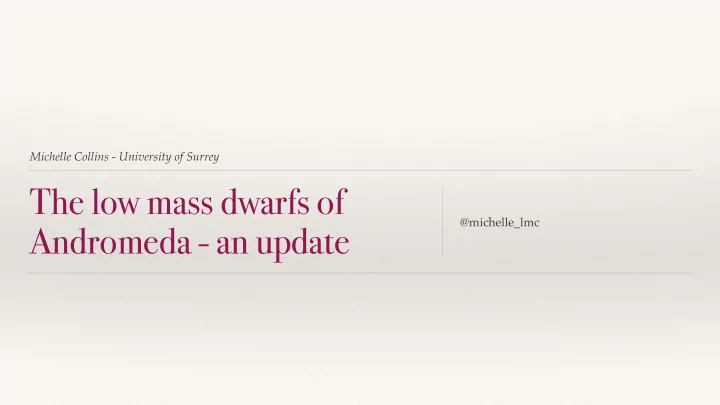

Michelle Collins - University of Surrey The low mass dwarfs of @michelle_lmc Andromeda - an update
Michelle Collins - University of Surrey The low mass dwarfs of @michelle_lmc Andromeda - an update
Michelle Collins - University of Surrey The unfinished works of @michelle_lmc Michelle Collins
The best stuff comes from my students Alexandra Gregory Janet Preston
Back in 2013/2014… • Measuring masses of all (known) Andromeda dwarf galaxies from spectra of Mass within half-light radius (Msun) red giant branch stars • Comparing with the Milky Way population • Identified a few low-mass outliers Galaxies being stripped? Extreme feedback? Just small number statistics? Or something else?!? Half-light radius (pc) More spectroscopy with Keck in 2012-2015 to answer these questions… Collins 2013, 2014, Tollerud 2012
So, where are the results? Data in hand, but life gets in the way • Two transatlantic moves • Exciting new projects with Janet and Alexandra • And exciting new projects with others! (PAndAS, Justin Read, Geraint Lewis, Ekta Patel, Erik Tollerud, Dave Sand, Duncan Forbes…) • Bad at saying no to panels… • Teaching and teaching and teaching… All takes a little adjusting to. Michelle 2014 Michelle 2019
But, now almost ready to publish! Or, at least, ready for an update And XIX (Collins+ submitted) And XXI (Collins, Read+ in prep) And XXV (results from an undergrad) 126 member stars 77 member stars 55 member stars
And XIX - a Local Smudge Bate et al. 2013 Effective radius (kpc) Stream Tidally stripped? Ultra-diffuse analogue? Low mass? Surface brightness (mag per sq. arcsec)
And XIX - a Local Smudge Velocity dispersion increased: σ v , 2013 = 4.7 +1.6 − 1.4 km/s σ v , 2019 = 7.8 +1.7 − 1.5 km/s Sample increased from 24 to 126 probable members
Why such a change? 2013 sample Possible substructure?
What does this mean for the mass? M31 dSph MW dSph Isolated dIrr Ultra diffuse Mass within half-light radius (Msun) Density within r_half Antlia 2 Antlia 2
Antlia 2 and And XIX Similar in size, stellar mass, and central density Torrealba et al. 2019 σ v = 7.8 +1.7 σ v = 5.7 ± 1.1 km/s − 1.5 km/s And XIX Antlia 2 M * = 1.1 × 10 6 M ⊙ M * = 0.88 × 10 6 M ⊙ r h = 2920 ± 311 pc r h = 3065 +955 − 1065 pc
Antlia 2 - hard to understand without feedback +tides The low density, and large half light radius make it difficult/impossible to understand without DM heating through feedback, combined with tidal stripping (Torrealba et al. 2019). Based on Erkal+19, has very close pericentre passage with Milky Way (~26 kpc) What about And XIX? Bate et al. 2013 • Also extremely large, and low density • (Tentative) velocity gradient • Evidence of irregular kinematics Stream • But, stream is not associated Paper 2: Dynamical modelling (heads up, Justin)
And XXI - still low mass Velocity dispersion: σ v , 2014 = 5.4 ± 0.9 km/s Sample increased from 32 to 77 likely members σ v , 2019 = 6.1 +1.0 − 0.9 km/s Collins, Read + in prep.
Remains a low mass & low density outlier Mass within r_half (Msun) Circular velocity (km/s) Density within r_half Half-light radius (pc) Half-light radius (pc) Half-light radius (pc) • Lower than expected density • Still consistent with low mass halo Collins, Read + in prep. • Can this be done with feedback? • GravSphere modelling with Justin Read
GravSphere Modelling 10 9 ❖ Jeans modelling of density profile 9.9 10 9 ❖ Use CoreNFW profile to fit data (surface 9.7 9.3 9.6 9.0 brightness profile + kinematics) 9.5 10 8 10 ρ [M � kpc � 3 ] 10 8 8.9 ❖ And XXI consistent with cored profile 5 ρ DM (150 pc) 8.9 10 7 Tides 2 ❖ Would need to form stars for almost a Hubble 0.5 time to explain density 10 6 10 7 ❖ HST imaging shows no stars younger than 3-5 10 5 Gyr (Martin et al. 2017) No stellar mass loss Stellar mass loss 10 4 ❖ Tides..? And XXI 10 � 1 10 0 10 1 10 6 10 − 3 r [kpc] Read, Walker and Steger (2018), Read et al. 2019, Read & Erkal 2019 M ∗ /M 200 Collins, Read et al. in prep.
And XXV - hot off the UG press Preliminary - Still working on membership Work by Emily Charles Velocity dispersion: σ v , 2013 = 3.0 +1.2 − 1.1 km/s σ v , 2019 = 5.8 +1.1 − 1.0 km/s From 25 to 52 stars
Still a bit of an outlier, but less extreme Mass within half-light radius (Msun) Density within r_half Next up - Working with Emily to refine analysis
Conclusions ❖ Increased membership in 3 ‘low mass’ dwarf galaxies ❖ And XIX - mass has gone up, but still quite low density ❖ And XXI - remains a low mass outlier - feedback plus tides? ❖ And XXV - mass has increased, more from Emily soon
Recommend
More recommend